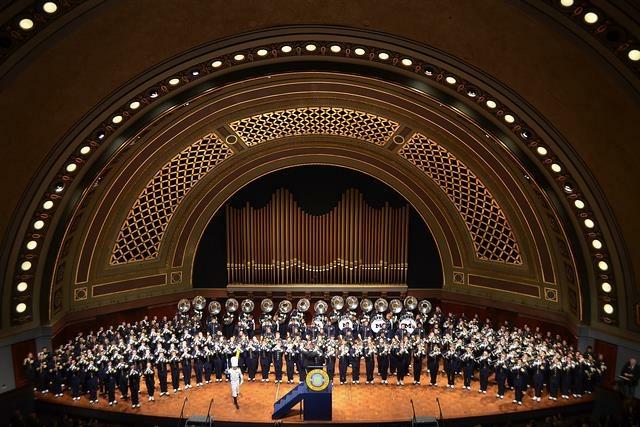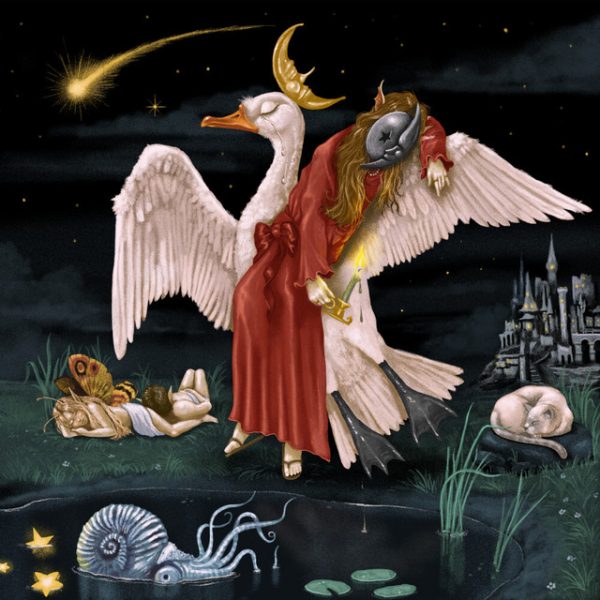2015 Band-O-Rama
The University of Michigan’s School of Music, Theatre & Dance puts on an annual show called Band-O-Rama at Hill Auditorium. It is not only tradition, but also caters to many types of musical interests. From classical music to drumline gymnastics, this year’s theme was “Ritmo de Azul,” meaning Rhythm of Blue, and the music followed tunes with a Latin or Spanish basis, but also had a hint of school spirit.
The emcee, Carl Grapentine, invited the audience with a booming game-announcer voice.
The program began with the Concert Band, directed by Courtney Snyder. The band performed three pieces: Amparito Roca by Jaime Teixidor, “Cakewalk” from Suite of Old American Dances by Robert Russell Bennett and Huapango by José Pablo Moncayo. They were followed by the Symphony Band, directed by Professor Michael Haithcock, which played Danzón no. 2 by Arturo Márquez, the Free Lance March— “On to Victory” by John Phillip Sousa and Victors Valiant by Jerry Bilik. Both Huapango and Danzón no. 2 are among the most popular Mexican contemporary classical music compositions performed. Danzón no. 2, originally written for orchestra, features solos including piano, trumpet, piccolo, oboe, soprano saxophone and clarinet. Huapango is known as the second unofficial anthem of Mexico.
Snyder joined the conducting faculty at U of M in 2014 as the Associate Director of Bands and Assistant Professor, where she also directs the Concert Band and teaches conducting to undergraduates. Haithcock became Director of Bands and Professor of Music (Conducting) at the U of M in 2001, and in Feb. 2012 he was awarded for excellence in undergraduate teaching. Both conducted each band in their own unique energetic way— Snyder with enthusiasm and Haithcock with gusto.
After a brief intermission, the Michigan Marching Band entered the stage. The ranks flowed in from behind the audience and continued to march on stage. The members took up almost all the space of the stage. They opened with the “M Fanfare,” “The Victors” and “Let’s Go Blue” followed by excerpts from their previous halftime shows (including Blackdog/Kashmir and Earth, Wind and Fire Opener). The band was loud, but still held accuracy in pitch and musicality, and the members also incorporated movements into their playing. The contrast from classical music, however, did not lose the theme “Ritmo de Azul,” because they performed many famous spanish pieces that also featured members of the UM Music school. The MMB was directed by many guest conductors, but the conductor was Dr. John Pasquale, and the associate conductor was Andrea Brown.
Pasquale is a member of the conducting faculty at the university and serves as Associate Director of Bands and Director of the MMB and Athletic Bands. He teaches classes in rehearsal pedagogy and wind literature, and holds a Master of Music degree in Instrumental Conducting.
The MMB portion was split into two by the drumline, which performed their acts with a thunderous volume and interspersed with acrobatics—playing the tenors upside down—and different formations, like making the Michigan “M” out of cymbals.
The 50th anniversary of the tradition finished with a bang, as the MMB concluded with “The Victors.” The audience, which filled the whole auditorium and was comprised of people from toddlers to elderly, cheered with equal enthusiasm to the music that was played.









